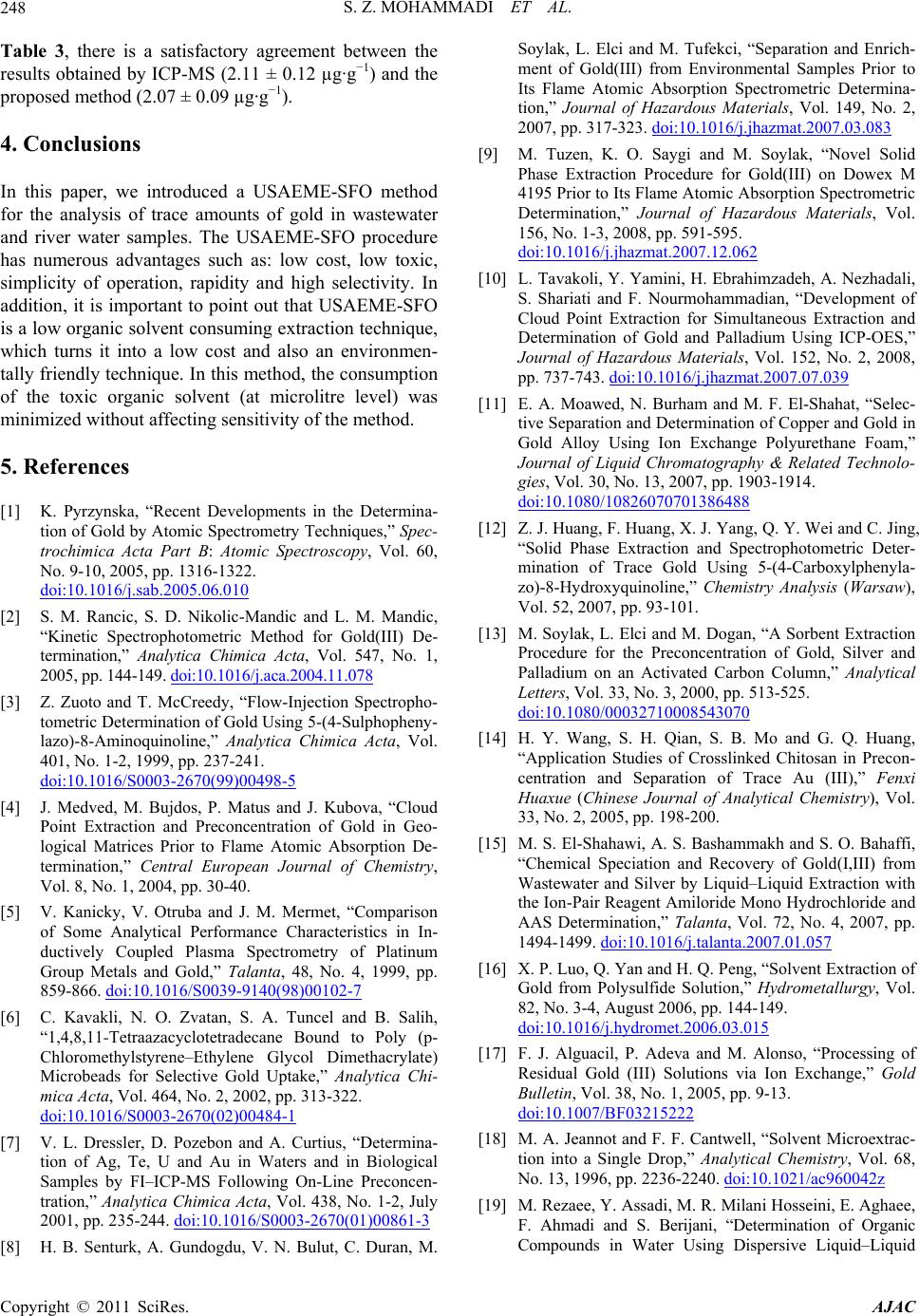
S. Z. MOHAMMADI ET AL.
248
Table 3, there is a satisfactory agreement between the
results obtained by ICP-MS (2.11 ± 0.12 µg·g−1) and the
proposed method (2.07 ± 0.09 µg·g−1).
4. Conclusions
In this paper, we introduced a USAEME-SFO method
for the analysis of trace amounts of gold in wastewater
and river water samples. The USAEME-SFO procedure
has numerous advantages such as: low cost, low toxic,
simplicity of operation, rapidity and high selectivity. In
addition, it is important to point out that USAEME-SFO
is a low organic solvent consuming extraction technique,
which turns it into a low cost and also an environmen-
tally friendly technique. In this method, the consumption
of the toxic organic solvent (at microlitre level) was
minimized without affecting sensitivity of the method.
5. References
[1] K. Pyrzynska, “Recent Developments in the Determina-
tion of Gold by Atomic Spectrometry Techniques,” Spec-
trochimica Acta Part B: Atomic Spectroscopy, Vol. 60,
No. 9-10, 2005, pp. 1316-1322.
doi:10.1016/j.sab.2005.06.010
[2] S. M. Rancic, S. D. Nikolic-Mandic and L. M. Mandic,
“Kinetic Spectrophotometric Method for Gold(III) De-
termination,” Analytica Chimica Acta, Vol. 547, No. 1,
2005, pp. 144-149. doi:10.1016/j.aca.2004.11. 078
[3] Z. Zuoto and T. McCreedy, “Flow-Injection Spectropho-
tometric Determination of Gold Using 5-(4-Sulphopheny-
lazo)-8-Aminoquinoline,” Analytica Chimica Acta, Vol.
401, No. 1-2, 1999, pp. 237-241.
doi:10.1016/S0003-2670(99)00498-5
[4] J. Medved, M. Bujdos, P. Matus and J. Kubova, “Cloud
Point Extraction and Preconcentration of Gold in Geo-
logical Matrices Prior to Flame Atomic Absorption De-
termination,” Central European Journal of Chemistry,
Vol. 8, No. 1, 2004, pp. 30-40.
[5] V. Kanicky, V. Otruba and J. M. Mermet, “Comparison
of Some Analytical Performance Characteristics in In-
ductively Coupled Plasma Spectrometry of Platinum
Group Metals and Gold,” Talanta, 48, No. 4, 1999, pp.
859-866. doi:10.1016/S0039-9140(98)00102-7
[6] C. Kavakli, N. O. Zvatan, S. A. Tuncel and B. Salih,
“1,4,8,11-Tetraazacyclotetradecane Bound to Poly (p-
Chloromethylstyrene–Ethylene Glycol Dimethacrylate)
Microbeads for Selective Gold Uptake,” Analytica Chi-
mica Acta, Vol. 464, No. 2, 2002, pp. 313-322.
doi:10.1016/S0003-2670(02)00484-1
[7] V. L. Dressler, D. Pozebon and A. Curtius, “Determina-
tion of Ag, Te, U and Au in Waters and in Biological
Samples by FI–ICP-MS Following On-Line Preconcen-
tration,” Analy tica Chimica Acta, Vol. 438, No. 1-2, July
2001, pp. 235-244. doi:10.1016/S0003-2670(01)00861-3
[8] H. B. Senturk, A. Gundogdu, V. N. Bulut, C. Duran, M.
Soylak, L. Elci and M. Tufekci, “Separation and Enrich-
ment of Gold(III) from Environmental Samples Prior to
Its Flame Atomic Absorption Spectrometric Determina-
tion,” Journal of Hazardous Materials, Vol. 149, No. 2,
2007, pp. 317-323. doi:10.1016/j.jhazmat.2007.03.083
[9] M. Tuzen, K. O. Saygi and M. Soylak, “Novel Solid
Phase Extraction Procedure for Gold(III) on Dowex M
4195 Prior to Its Flame Atomic Absorption Spectrometric
Determination,” Journal of Hazardous Materials, Vol.
156, No. 1-3, 2008, pp. 591-595.
doi:10.1016/j.jhazmat.2007.12.062
[10] L. Tavakoli, Y. Yamini, H. Ebrahimzadeh, A. Nezhadali,
S. Shariati and F. Nourmohammadian, “Development of
Cloud Point Extraction for Simultaneous Extraction and
Determination of Gold and Palladium Using ICP-OES,”
Journal of Hazardous Materials, Vol. 152, No. 2, 2008,
pp. 737-743. doi:10.1016/j.jhazmat.2007.07.039
[11] E. A. Moawed, N. Burham and M. F. El-Shahat, “Selec-
tive Separation and Determination of Copper and Gold in
Gold Alloy Using Ion Exchange Polyurethane Foam,”
Journal of Liquid Chromatography & Related Technolo-
gies, Vol. 30, No. 13, 2007, pp. 1903-1914.
doi:10.1080/10826070701386488
[12] Z. J. Huang, F. Huang, X. J. Yang, Q. Y. Wei and C. Jing,
“Solid Phase Extraction and Spectrophotometric Deter-
mination of Trace Gold Using 5-(4-Carboxylphenyla-
zo)-8-Hydroxyquinoline,” Chemistry Analysis (Warsaw),
Vol. 52, 2007, pp. 93-101.
[13] M. Soylak, L. Elci and M. Dogan, “A Sorbent Extraction
Procedure for the Preconcentration of Gold, Silver and
Palladium on an Activated Carbon Column,” Analytical
Letters, Vol. 33, No. 3, 2000, pp. 513-525.
doi:10.1080/00032710008543070
[14] H. Y. Wang, S. H. Qian, S. B. Mo and G. Q. Huang,
“Application Studies of Crosslinked Chitosan in Precon-
centration and Separation of Trace Au (III),” Fenxi
Huaxue (Chinese Journal of Analytical Chemistry), Vol.
33, No. 2, 2005, pp. 198-200.
[15] M. S. El-Shahawi, A. S. Bashammakh and S. O. Bahaffi,
“Chemical Speciation and Recovery of Gold(I,III) from
Wastewater and Silver by Liquid–Liquid Extraction with
the Ion-Pair Reagent Amiloride Mono Hydrochloride and
AAS Determination,” Talanta, Vol. 72, No. 4, 2007, pp.
1494-1499. doi:10.1016/j.talanta.2007.01.057
[16] X. P. Luo, Q. Yan and H. Q. Peng, “Solvent Extraction of
Gold from Polysulfide Solution,” Hydrometallurgy, Vol.
82, No. 3-4, August 2006, pp. 144-149.
doi:10.1016/j.hydromet.2006.03.015
[17] F. J. Alguacil, P. Adeva and M. Alonso, “Processing of
Residual Gold (III) Solutions via Ion Exchange,” Gold
Bulletin, Vol. 38, No. 1, 2005, pp. 9-13.
doi:10.1007/BF03215222
[18] M. A. Jeannot and F. F. Cantwell, “Solvent Microextrac-
tion into a Single Drop,” Analytical Chemistry, Vol. 68,
No. 13, 1996, pp. 2236-2240. doi:10.1021/ac960042z
[19] M. Rezaee, Y. Assadi, M. R. Milani Hosseini, E. Aghaee,
F. Ahmadi and S. Berijani, “Determination of Organic
Compounds in Water Using Dispersive Liquid–Liquid
Copyright © 2011 SciRes. AJAC